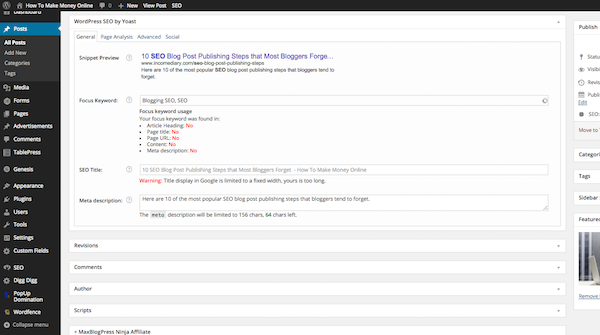
I see this time and time again.
As people get started with blogging, they think it’s as simple as clicking, “Add New Post,” typing up a few paragraphs, and clicking, “Publish.”
Then they hopelessly wait for views, comments, and tweets. No one comes. No one comments. No one tweets.
They do this three or four times and eventually write off blogging as, “not it’s all hyped up to be.”
After writing for Michael for a few months now, I can tell you that there are dozens of small blogging nuances that we work into nearly every post.
Here are 10 of the most popular SEO blog post publishing steps that bloggers tend to forget.
1. Keyword Research
Before I write a single word, I figure out if it’s something that people are asking about. And if they are, I want to know if the internet is already saturated with that type of content.
To figure this out, I do two things:
- Google’s Keyword Tool – I look up the words I believe people would search for to find the post I plan on writing.
- Google – I google those keywords to see the actual competition.
By now, I can look at a series of search results and determine how well I’ll be able to rank for a keyword.
I want this post to rank for “seo blog post publishing steps” (click to see how it’s doing).
For more clarification on this tip, read this comment below.
2. Fine-Tuning the Headline
Here’s my formula for crafting headlines for list posts:
[#][keyword][ curiosity-capturing phrase]
For title tag SEO, your goal is to place the keyword as near to the front of the headline as possible:
- Top 10 Motivational YouTube Videos for Entrepreneurs
- 20 Great Google Chrome Extensions for Online Entrepreneurs
- 20 Best Designed Pricing Comparison Tables
For that last one, I switched the keyword with the curiosity phrase because “Best Designed” was another phrase that people tack on to the base keyword.
3. Post Slug
The post slug is what shows up after the domain for every post or page.
When you type a headline, WordPress generates the post slug by placing every word in the headline into the slug. This clutters it up with lots of small words.
Instead, change your post slug to your primary keyword.
Default: /10-seo-blog-post-publishing-steps-that-most-bloggers-forget/
Ideal: /seo-blog-post-publishing-steps/
4. Images
We all know that images grab your attention, break up the content, and supplement your ideas. But they also add great SEO benefits, as long as you follow these steps:
- Save your images as [keyword-phrase.png] before you upload them to your site.
- Add alt text as [keyword phrase].
- Add title tag as [keyword phrase].
These rules apply to your featured image and the images within your posts. For the images within the content, however, use other similar and relevant keywords.
5. Relevant Videos
Google understands that adding a video to a blog post makes it a more complete resource. If they haven’t already boosting blog posts with videos, they will eventually.
If blogging is a big portion of your business, start making videos for your posts, upload them to your channel, and embed them in the actual post.
If you’re still dabbling in blogging, consider embedding other peoples’ videos in your posts.
6. Subheads
Similar to images, subheadings break up the content and make blog posts easier to read. They also have big-time SEO benefits.
When a search engine robot hits a page, it reads the headline/title tag first. Then it reads the H2, H3, and H4 tags.
When you add subheadings to your content, proper HTML is:
<h2>Subhead Level 1</h2>
<h3>Subhead Level 2</h3>
<h4>Subhead Level 3</h3>
Note: The headline/title tag should be automatically wrapped in <h1></h1>.
So… Stop simply bolding and italicizing your subheads.
7. Interlinking
Another important step that most people forget is interlinking between posts.
Before you publish a new post, read through it and try to find two-three opportunities to naturally link back to relevant posts on your blog.
This keeps both readers and search spiders on your site longer.
8. External Linking
Also, look for opportunities to link to other bloggers. The SEO benefits of external linking are unclear, but Neil Patel says:
“Did you know that an external links going out to these high authority sites can boost your SEO? When search engines crawl your site and see a link and follow it to CNN or Huffington Post, they weight it as a positive. The trick is to find organic ways to link to these sites, like I did in this post.”
Linking to other sites is also a good way to build relationships with other bloggers.
I’ve received two “thank you” emails from important people because I chose to link to their sites on IncomeDiary posts.

I linked to Pat’s site on: 10 Blog Posts that Made an Everlasting Impact on Me

I linked to Giancarlo’s site on: 10 Weird Ways Big Companies Make Money Online
Bloggers notice and appreciate backlinks.
9. Meta Data
Whether or not Google still looks at meta keywords is up for debate, but the meta description is definitely still used.
In a search result, your meta description often shows up as the little blurb beneath the blue link. In writing your meta description, you need to keep three things in mind:
- It needs to be fewer than 155 characters so Google will display the whole description.
- It needs to include your keywords because Google bolds them in search results.
- It should be an actual sentence from the post because people look for that sentence once they arrive.
I always summarize the post with the keywords in the last sentence of the introduction and use that as the meta description.
10. Call to Action
The final step is the call-to-action. As with any piece of marketing material, a blog post should be designed to get someone to do something.
Here are a few popular calls to action:
- Comment – You can encourage people to comment by ending the post with a thought-provoking question or simply asking them to let you know what they think.
- Share – “If you liked this post, tweet it out.”
- Implement – I believe the best result of any blog post is for a reader to take your advice and implement it.
The main reason I’ve been following IncomeDiary for so long is because I constantly find myself implementing Michael’s advice. When I see the benefits to following his advice, it makes me want to come back for more.
Now you have a choice. You can comment, share, or implement. I prefer if you implement, but I’ll appreciate all three.
Image by: Stuck in Customs




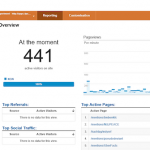
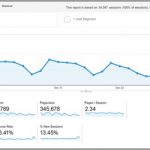


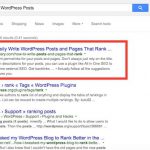


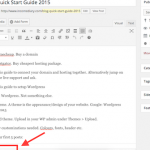
Pingback:My Homepage